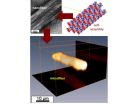(Press-News.org) A clinical drug trial conducted in five Sub-Sahara African countries shows that a shortened (four month) treatment for tuberculosis (TB) is well tolerated and may work well in subsets of TB patients, but overall could not be considered as an alternative to the current six month standard treatment. The results of the study were published in the New England Journal of Medicine.
TB remains a significant public health problem worldwide. There were an estimated 8.6 million people who developed TB and 1.3 million died from the disease in 2012. The study was designed to verify whether replacing one of the four drugs of the standard regimen with gatifloxacin could shorten the overall treatment duration of TB from six to four months.
The new treatment was found to be safe and cleared the lungs from TB bacteria rapidly, but a proportion of patients relapsed within months after treatment ended. The shortened treatment appeared beneficial to patients with no TB cavitation in their lungs, undernourished patients, and people living with HIV, but it was less effective among other groups. Therefore, this shortened regimen could not be recommended to replace the current treatment, though the difference in effectiveness between the two treatments varied considerably across the different countries where the study took place.
"The standard treatment is very effective if taken for the full six months," says Dr Christian Lienhardt, who initiated the study while at the Institut de Recherche pour le Développement (IRD) and who now works at the World Health Organization. "But in reality, many do not do this. Poor patient adherence to treatment may increase the risk of TB becoming drug resistant and thus potentially fatal. Shortening treatment duration remains, therefore, a global priority, as it would lead to more patients following the complete treatment."
The study enrolled over 1,800 patients in five African countries (Benin, Guinea Conakry, Kenya, Senegal and South Africa). Half of the patients received the standard six month treatment (rifampicin, isoniazid, pyrazinamide and ethambutol); the other half received the shortened four month treatment with gatifloxacin replacing ethambutol.
"While, unfortunately, the results do not support a much-needed shortened TB regimen," says Dr Piero Olliaro, an author and head of TDR's intervention and implementation research, "this study will teach us a lot about TB treatment response. For example, three of the African partners were TB national programmes, showing that high-level clinical research can be embedded in national control programmes, which is one of our goals."
The trial is the result of broad collaboration between two sponsors, three national African TB programmes (Benin, Guinea Conakry and Senegal), two African research institutes (Kenyan Medical Research Institute in Nairobi, Kenya and Medical Research Council in Durban, South Africa) and four European institutions: Assistance Publique - Hôpitaux de Paris (France), St Georges Hospital Medical School (UK), the Institute of Tropical Medicine in Antwerp (Belgium), and the London School of Hygiene & Tropical Medicine (UK).
"The study will help improve the way future studies of TB will be conducted, due to the investments made in strengthening capacities for quality clinical trials in highly endemic TB countries," said Dr Corinne Merle, the study coordinator from the London School of Hygiene & Tropical Medicine. "Given the variety of TB drugs that are currently in the development pipeline, these skills will continue to be needed."
This was a large study with 1,356 patients from five countries, noted the trial statistician Dr Katherine Fielding from the London School of Hygiene & Tropical Medicine. "Additional analyses of our data and combining data from other trials will be essential to continue the search for new and improved TB treatments."
"We have ethical, scientific and economic obligations to make the best out of this and other recent TB trials," says Olliaro. "Sharing data will help shorten the journey to the next TB regimen." TDR is organising consultations with stakeholders on the establishment of a TB clinical data sharing platform and community of practice.
INFORMATION:
The trial was co-sponsored by TDR, the Special Programme for Research and Training in Tropical Diseases and the Institut de Recherche pour le Développement (IRD). The study was funded by TDR and the European Commission. TDR is a co-sponsored programme based at the World Health Organization, and co-sponsored by UNICEF, UNDP, the World Bank and WHO.
For further information or to request an interview please contact the London School of Hygiene & Tropical Medicine press office: +44(0)20 7927 2802 or press@lshtm.ac.uk, or
Dr Piero Olliaro, TDR olliarop@who.int
Notes to editors:
Corinne Merle, Katherine Fielding, Piero Olliaro, Christian Lienhardt et al. A Four-Month Gatifloxacin-Containing Regimen for Treating Tuberculosis. New England Journal of Medicine. DOI: 10.1056/NEJMoa1315817 http://www.nejm.org/doi/full/10.1056/NEJMoa1315817
Listen to Corinne Merle and Katherine Fielding discuss the study in this podcast interview https://soundcloud.com/lshtm/tbtreatment
About the London School of Hygiene & Tropical Medicine
The London School of Hygiene & Tropical Medicine is a world-leading centre for research and postgraduate education in public and global health, with 3,900 students and more than 1,000 staff working in over 100 countries. The School is one of the highest-rated research institutions in the UK, and was recently cited as the world's leading research-focused graduate school. Our mission is to improve health and health equity in the UK and worldwide; working in partnership to achieve excellence in public and global health research, education and translation of knowledge into policy and practice. http://www.lshtm.ac.uk
New Rochelle, NY, October 23, 2014–Rapid lowering of body temperature following an acute myocardial infarction (MI) can be an effective therapeutic strategy to minimize damage to the heart muscle caused by the loss and restoration of blood flow to the heart. While hypothermia shows clinical promise, current methods to cool the heart are insufficient. Faster, more effective techniques are needed to realize the full cardioprotective potential of this emerging intervention, as described in an article in Therapeutic Hypothermia and Temperature Management, a peer-reviewed ...
CHAMPAIGN, Ill. — A new study finds that most U.S. adults fail to meet recommended daily levels of 10 key nutrients, and those with disabilities have even worse nutrition than average.
An estimated 10 to 25 percent of U.S. adults fit into one or more category of disability, from those who have difficulties with activities of daily living, such as dressing, bathing and eating, to those who cannot use their legs or struggle to accomplish routine tasks, such as money management or household chores.
To determine how these physical or mental difficulties can affect ...
URBANA, Ill. – Although it would seem logical that large numbers of roosting birds would attract more mosquitoes that carry West Nile virus and contract the disease when bitten, recent research at the University of Illinois found the opposite to be true. That is, when large groups of birds roost together the chances that an individual bird will get bitten by mosquitoes carrying West Nile virus and subsequently contract the disease actually go down.
"Our study is the first field-based evidence to support what's called the 'encounter-dilution effect' acting in a ...
COLUMBUS, Ohio: Astronomers have gotten the closest look yet at what happens when a black hole takes a bite out of a star—and the star lives to tell the tale.
We may think of black holes as swallowing entire stars—or any other object that wanders too close to their immense gravity. But sometimes, a star that is almost captured by a black hole escapes with only a portion of its mass torn off. Such was the case for a star some 650 million light years away toward Ursa Major, the constellation that contains the "Big Dipper," where a supermassive black hole tore ...
Using a technique that illuminates subtle changes in individual proteins, chemistry researchers at Cornell University have uncovered new insight into the underlying causes of Amyotrophic Lateral Sclerosis (ALS).
Brian Crane, professor of chemistry and chemical biology, led one study and co-authored a follow-up on a spectroscopic method that detects subtle changes to copper-containing proteins in solution. He and Jack Freed, professor of physical chemistry, have developed the method together with Petr Borbat, associate director of Cornell's National Biomedical Center for ...
ITHACA, N.Y. – To solve a mental puzzle, the brain's executive control network for externally focused, goal-oriented thinking must activate, while the network for internally directed thinking like daydreaming must be turned down to avoid interference – or so we thought.
New research led by Cornell University neuroscientist Nathan Spreng shows for the first time that engaging brain areas linked to so-called "off-task" mental activities (such as mind-wandering and reminiscing) can actually boost performance on some challenging mental tasks. The results advance ...
Researchers at the New York University Polytechnic School of Engineering have broken new ground in the development of proteins that form specialized fibers used in medicine and nanotechnology. For as long as scientists have been able to create new proteins that are capable of self-assembling into fibers, their work has taken place on the nanoscale. For the first time, this achievement has been realized on the microscale—a leap of magnitude in size that presents significant new opportunities for using engineered protein fibers.
Jin Kim Montclare, an associate professor ...
In this image taken by the Aqua satellite of the southern United States actively burning areas as detected by MODIS's thermal bands are outlined in red. Each red hot spot is an area where the thermal detectors on the MODIS instrument recognized temperatures higher than background. When accompanied by plumes of smoke, as in this image, such hot spots are diagnostic for fire. These fires are a combination of small wildfires and prescribed fires. On the U.S. Forest Service website a prescribed fire is set to reduce tree overcrowding, revive fire-dependent species and reduce ...
Despite a dramatic increase in public awareness and anti-bullying legislation nationwide, the prevalence of bullying is still one of the most pressing issues facing our nation's youth, according to a report by researchers from Clemson University and Professional Data Analysts Inc., and published by the Hazelden Foundation.
"Bullying continues to affect a great number of children in all age groups, with the highest prevalence observed in third and fourth grades, where roughly 22 percent of schoolchildren report that they are bullied two or three times or more per month," ...
A new test, developed by University of British Columbia researchers, could help physicians predict within an hour if a patient will develop severe sepsis so they can begin treatment immediately.
Sepsis, a syndrome caused by infection, leads to organ failure and is responsible for up to five million deaths annually. There are 18 million cases of sepsis worldwide every year.
The discovery could cut back on the lengthy diagnostic time usually required to confirm if a patient is suffering from sepsis and increase the odds that they will respond to treatment.
"We identified ...




